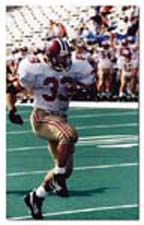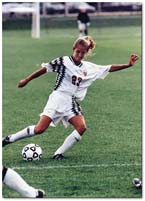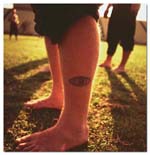
Main Menu ·
Search ·Current
Issue ·Contact ·Archives
·Centennial ·Letters
to the Editor ·FAQs

Check out the athletic department's schedule listing for updated sports information.
 |
Senior halfback Eion Hu ran for 118 yards in the season's opening game, a 20-13 overtime loss to Columbia. On his fourth carry, Hu broke Harvard's all-time career rushing record. Phtotgraph by Tim Morse
|
For the Record
Eion Hu now sets one with each yard he gains
"Put your enemy in the wrong-and keep him there" was the maxim
espoused by Samuel Adams, A.B. 1740, political agitator and life of the
Boston Tea Party. By and large, Harvard football teams of the past decade
have seemed unaware of it. This season's opening-game loss to Columbia was
a case in point. Chiefly because of the footwork of halfback Eion Hu '97--who
broke a school rushing record in the second quarter--the Crimson had the
Lions down 13-0 at the half. But turnovers and a bungled field goal try
in the final quarter let Columbia tie the game, which then went into overtime
(a mandatory requirement, alas, in Division I-A and I-AA college football
this fall). The outcome was settled swiftly. Columbia scored on its first
possession, came up with an interception when Harvard was given the ball,
and was duly credited with a 20-13 victory.
"It never should have gotten to overtime," said Harvard coach
Tim Murphy. "We had our foot on their throats a good part of the game
and we didn't finish them off."
Hu's big day was the bright spot for Harvard followers. The rest of the
action was ruled by turnovers. A weak Columbia punt, a misdirected pass,
and a fumble gave Harvard a pair of field goals and a touchdown in the second
period. A Harvard fumble and three interceptions let the Lions out of their
cage in the second half. They caught up with a touchdown and two fourth-period
field goals, the second a 48-yarder that dinged the crossbar and tied the
game.
Hu promptly responded with a 52-yard breakaway run that took Harvard deep
into Lion country. The Crimson advanced to the one-yard line, then got hit
with a five-yard delay-of-game penalty that prompted coach Murphy to opt
for what looked like an easy field goal, with 1:36 on the clock. But the
snap from center was high, and the kick was blocked by Marcellus Wiley,
the Lions' behemoth defensive end. Harvard came away empty-handed, and the
5,760 in attendance had the novel experience of witnessing an Ivy League
tie-breaker. Columbia, an opening-game pushover for almost 20 years, has
now beaten Harvard twice in a row-for the first time since the early 1950s.
Tim Fleiszer '98, a converted fullback, played a strong game at defensive
end. Jay Snowden, another junior, started his first game at quarterback.
He completed 10 of 24 passes and had three picked off. He also punted, but
his work was subpar: seven kicks, 27-yard average. Freshman Chris Menick
made a promising debut at halfback: 25 carries, 91 yards. Ryan Korinke '99,
who made good on four out of seven field goals a year ago, handled the place-kicking,
nailing two of three field goal attempts and a point-after.
Hu scored the team's only touchdown on a six-yard carry. It was his twenty-first
in 20 varsity games (his class was the last to participate in freshman football).
Nursing a hamstring injury sustained in preseason practice, Hu was not at
full strength. Even so, he came off the field with 118 yards rushing and
a career total of 2,230 yards. On his fourth carry he eclipsed the career
record of 2,130 yards set in 1968 by Vic Gatto '69. Hu now breaks his own
record with each yard he gains, but after the overtime loss to Columbia
he was inconsolable. "The record doesn't mean anything to me,"
he said at a postgame press conference. "Today was terrible. I missed
two blocks and fumbled."
Hu came through the next weekend, scoring twice and rushing for 113 yards
as Harvard rocked Bucknell, 30-7. But the day's most spectacular effort
came from the Crimson defensive unit. Its members held the Bison offense
to minus 4 yards rushing and sacked quarterback Jim Fox five times. Rich
Lemon, Bucknell's all-time leading rusher, finished the game with 12 carries
and minus 9 yards.In its home opener a week later, Harvard lost a hard-fought
contest to Lafayette, 17-7. The Leopard defenders employed an eight-man
line to put pressure on Snowden, and Harvard couldn't mount a consistent
passing attack. Still nursing his muscle pull, Hu gained 69 hard-earned
yards. Snowden, a strong runner, scored Harvard's only touchdown on a 32-yard
keeper.
Golden oldies: The Great Gatto's 28-year-old rushing record, now
eclipsed, dates from the finale of the 1968 season, when unbeaten Harvard
scored 16 points in the last 42 seconds to tie Yale, 29-29. Gatto pulled
a hamstring and played only in spots, but it was he who caught Frank Champi's
last-gasp touchdown pass as time expired. In those days a tie really meant
something.
Hard times: From 1991 to 1995, Harvard teams had an overall won-lost-tied
record of 16-33-1, the poorest for any comparable period since the early
1950s. Only the squads of 1949 (1-8) and 1950 (1-7)-when Harvard's governors
began thinking about dropping football-posted sorrier records than last
year's (2-8).
Enfin: The 1996 squad has its merits-aggressive defensive crew, fine
receivers, Eion Hu. But the start of this fall's campaign made it clear
that the passing attack and the kicking game needed lots of attention, and
that coach Murphy's young team still had much to learn about keeping the
enemy at bay. A crash course on the theories of Samuel Adams might help.
Harvard's soccer teams had fun at Columbia. Both posted decisive victories:
4-1 for the men's team, 3-0 for the women's. All-American Emily Stauffer
'98, Kristen Bowes '98, and Naomi Miller '99 scored for the women's team.
In the men's game Rich Wilmot, a big senior forward, put in two of the goals;
John Vrionis '97 and Tom McLaughlin '98 got the others. Speedy Kevin Silva
'97, sidelined last year by a leg injury, contributed two assists. Jordan
Dupuis '99, a New Zealander, split the goalkeeping duties with veteran Peter
Albers '97. Harvard had opened its season with a 3-1 loss to Cornell, the
defending Ivy League champions.
The men didn't look ready for prime time against Cornell, but the Columbia
match was the takeoff point for the longest winning streak enjoyed by the
men's team since the Ivy championship season of 1987. Victims included nationally
ranked Boston University (2-1), Yale (4-3, overtime), Central Connecticut
(3-0), Lafayette (3-0), and Pennsylvania (2-0). Four stellar veterans from
the Greater Philadelphia area-captain Will Kohler '97, T.J. Carella '97,
McLaughlin, and Silva-made the most of their road trip to Pennsylvania.
Kohler and Carella each had a goal and an assist at Lafayette; Carella's
penalty kick gave Harvard an early lead over Penn, and Silva put in the
insurance goal on a pass from McLaughlin.
Fast competition: The field hockey team posted a 1-0 victory over
William and Mary in a September tournament hosted by Duke University. Duke's
roundballers had edged Harvard, 2-1, the previous day. . . . In men's water
polo, Mike Zimmerman '99 popped in five goals as Harvard posted a 17-5 victory
over Washington and Lee at a Naval Academy tournament. He'd scored four
as Harvard lost to the Middies, 12-7, a day earlier. . . . When the women's
volleyball team was shut out, 3-0, by George Washington University, its
record fell to 1-5. But hey, the season is young yet. -"Cleat"
Beautiful Feet
 |
The Merlin of midfield: soccer genius Emily Stauffer in action. Photograph by Tim Morse
|
The fact that Michael Jordan also wears number 23 is only coincidence; Emily
Stauffer '98 chose that number to celebrate her birthday, June 23. But Stauffer's
dazzling dexterity with a soccer ball does occasionally suggest Jordan's
talent with a slightly larger sphere. "She's just magic," says
her coach, Tim Wheaton. "Emily can make that ball do whatever she wants."
A First Team All-American last year, Stauffer is clearly one of the most gifted
athletes ever to head a ball on Ohiri Field. After four games this fall,
she had netted five goals and two assists, including a three-goal outburst
in the first half against Boston College. On the first of those,
Stauffer took a pass from Rebe Glass '98 and then ran a solo aria against
one overmatched defender; the score had an artful elegance. What's more,
Stauffer now exercises her genius amid a sparkling array of teammates, and
the Harvard side has become a formidable power in women's soccer.
Undefeated Ivy League champions last fall, Harvard nonetheless received
no bid to the NCAA tournament. Why? Some felt the schedule needed toughening.
So this year, Harvard has scheduled the University of Hartford, a top-20
team last fall, and the University of Connecticut, a top-5 side. On their
way to those contests, the Crimson began the season by knocking off New Hampshire
(2-1), Columbia (3-0), Boston College (4-1), and Yale (2-1).
The Bulldogs were the most tenacious of those opponents. Yale took a 1-0
lead by the half, using an effective if tedious strategy of clogging the midfield
with bodies. But in the second stanza Harvard spread out the slower, less-nimble
women from Yale and played most of the game in Yale's end. Yet frustrations
continued; overall, Harvard took 26 shots to Yale's seven. At one point,
the powerful, dangerous forward Keren Gudeman '98 nearly broke the crossbar
with a rocket that bounced out, not in. Finally, with about 14 minutes left,
freshman Gina Foster found the net to tie the score at 1-1 and the crowd
at Ohiri erupted, releasing more than an hour of pent-up tension. Then Harvard
kept pressuring Yale; in a breathtaking finish, quicksilver forward
Naomi Miller '99 blasted a left-footer past the Yale goalie for the winning
score, with only 11 seconds left on the clock.
In addition to Stauffer, Miller, and Gudeman, Dana Tenser '97, Kristen Bowes
'98, and Devon Bingham '99 are all serious scoring threats. A measure of
Harvard's overwhelming offense: after four games, the team had outshot its
opponents 95 to 17, more than 5 to 1. Goalkeepers Jennifer Burney '99 and
Anne Browning '00 were becoming the Maytag women of Ohiri Field, with only
nine saves between them over the first four contests. Even so, Wheaton's
priority is to move the entire defensive effort up a notch. Add that to Harvard's
awesome firepower, and there's no telling how far these women could
go.
Team Transcripts
 |
Offensive lineman Matt Birk '98 exposes his loyalties in Vanity Fair. Photograph by Peggy Sirota for Vanity Fair
|
In September, Vanity Fair magazine revived an old tradition of spotlighting
Ivy League football players by printing a group photograph of gridiron stars
from each of the Ancient Eight. Harvard's representatives were Eion Hu '97
(see page 70) and Matt Birk '98. In September, Burger King named Hu, an
economics concentrator, its "Scholar-Athlete of the Week," and
donated $10,000 to Harvard's general scholarship fund in his name.
Although Hu may exemplify the scholar-athlete, some of the best sports prospects
in secondary schools look less impressive on the transcript than on the
field. To ensure that Ivy League sports teams represent their schools
academically as well as athletically, the League in the early 1980s formulated
a guideline known as the "academic index," using a statistic called
the standard deviation, which measures the degree of variability or dispersion
in a population. "The idea was that, if you put all athletes together,
they'd be within one standard deviation of the class average," says
dean of admissions and financial aid William Fitzsimmons '67, Ed.D.
'71. "We did not want a separate athlete population."
The index uses Scholastic Aptitude Test (SAT) scores, class rank information,
and achievement test scores to compute benchmarks for each class, and a
rolling average for the four classes in college at any one time. Each of
the three components contributes up to 80 points to the total. A freshman
whose standardized test scores were all 800s and who ranked first in
a class of 2,000 would score the maximum of 240 on the academic index. The
Ivies impose a "fioor" of 169 for all recruits. As a general
rule, the group of recruited athletes within each sport must fall within
one standard deviation of their college's academic index.
The rub--at least for some coaches--is that different colleges have
different academic benchmarks, so the Ivy playing field is not level
in terms of recruiting. In index terms, Harvard, Yale, and Princeton are
at the top of the league (with Harvard atop that triumvirate), confining
H-Y-P coaches to a more academically rarefied group of athletes. Carolyn
Campbell, senior associate director of the Ivy League office, explains that,
unlike the case with intercollegiate sports competition, "Students
at different colleges don't compete with each other academically. Scholastically,
Harvard students compete with other Harvard students, not with Penn students."
Yale football coach Carmen Cozza, now in his final season, has publicly
declared his opposition to the academic index. Tim Murphy, his counterpart
at Harvard, declines to comment, as does Harvard athletic director Bill
Cleary '56. But in terms of recruiting athletes, the index is widely perceived
to favor schools with lower numbers--Penn, Columbia, and Brown. Even so,
Princeton last year won the Ivies in football, and captured 10 more league
championships-the most any member college had amassed in the league's 40-year
history.
Factors like "early decision" admissions-which Princeton and Yale
began last year-complicate the recruitment scenario. Early decision commits
students to the college that has accepted them by December of their senior
year. Harvard and Brown offer "early action," which assures an
applicant of admission but allows applications to other schools to go forward,
with the student choosing a college in the spring of senior year. Differences
in yield-the percentage of those accepted who enroll-also play a part. Harvard's
yield is generally the highest of any college; for the class of 2000, it
was an extraordinary 78 percent.
What this means in practical terms is that if Harvard can successfully recruit
an athlete who gains admission, there is an excellent chance of that athlete
playing for the Crimson. Fitzsimmons notes that there's a sequential process:
after being recruited, you have to apply, be accepted, and matriculate.
Then you have a chance to make the team. How successful that team
is in Ivy competition--in, say, football--is another matter. At Yale, openly,
and at Harvard, quietly, it's this last question that's being talked about
in athletic circles.
Main Menu ·
Search ·Current
Issue ·Contact ·Archives
·Centennial ·Letters
to the Editor ·FAQs

![]()
![]()

